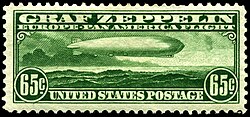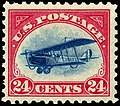| Postal administration | Year | Denominations | Notes |
|---|
| Argentina | 1931 | 5¢, 18¢, 90¢ | black overprint on 5¢, 18¢
red overprint on 90¢ [1] : 492 |
|---|
| Bolivia | 1930 | 5c on 10c, 10c, 15c, 25c, 50c, 1b | overprint "CORREO AEREO / R. S. 6–V–1930"
5c on 10c has additional "5 CTS." overprint
10c known in black and bronze overprint
50c known in red and bronze overprint [1] : 908 |
|---|
| Brazil | 1931 | 2500r on 200r, 500r on 300r
2500r on 3000r | overprint "ZEPPELIN / 2$500"
overprint "2.500 REIS" [1] : 1025–26 |
|---|
| 1932 | 3500r on 5000r
7000r on 10,000r | overprint "ZEPPELIN / 3$500" [1] : 1025–26 |
| Cyrenaica | 1933 | 3l, 5l, 10l, 12l, 15l, 20l | Zeppelin and clouds forming Pegasus
Zeppelin and ancient galley
Zeppelin and giant bowman [2] : 668 |
|---|
| Egypt | 1931 | 50m on 27m, 100m on 27m | bilingual overprint "GRAF ZEPPELIN / AVRIL 1931"
overprint error "1951 instead of "1931" [2] : 979 |
|---|
| Finland | 1930 | 10m | overprint "ZEPPELIN / 1930" forgeries are known
error "1830" for "1930" [2] : 1112 |
|---|
| Germany | 1928 -31 | 1m, 2m, 4m | stamps show Graf Zeppelin crossing ocean [3] : 163 |
|---|
| 1930 | 2m, 4m [note 1] | overprint "(logo) / SÜDAMERIKA / FAHRT" [3] : 163 |
| 1931 | 1m, 2m, 4m [note 1] | brown overprint "POLAR– / FAHRT / 1931" [3] : 163 |
| 1933 | 1m, 2m, 4m [note 1] | overprint "Chicagofahrt / Weltaustellung / 1933" for Chicago World's Fair flight [3] : 163 |
| Greece | 1933 | 30d, 100d, 120d | Zeppelin over Acropolis [3] : 427 |
|---|
| Hungary | 1931 | 1p | overprint "Zeppelin / 1931" on Turul carrying messenger stamp [3] : 766 |
|---|
| Iceland | 1931 | 30a | regular issue overprinted "Zeppelin / 1931" [3] : 799 |
|---|
| Italy | 1933 | 3l, 5l, 10l, 12l, 15l, 20l | Zeppelin over pyramid of Caius Cestius [3] : 1166 |
|---|
| Liechtenstein | 1931 | 1fr, 2fr | 1fr - Zeppelin over Naafkopf Falkniz Range
2fr Zeppelin over Valüna Valley [4] : 500 |
|---|
| 1936 | 1fr, 2fr | Airship Graf Zeppelin [4] : 500 |
| Paraguay | 1935 | 3p on 4p, 4p | overprint "Cerreo Aéreo / (Zeppelin image) / ""Graf Zeppelin""
the Zeppelin image was handstamps while the text was printed [5] : 150 |
|---|
| Russia | 1930 | 40k 80k | Zeppelin and "Call to Complete 5-year Plan in 4 Years"
for Graf Zeppelin flight from Friederichshafen to Moscow and return [5] : 706 |
|---|
| 1931 32 | 10k, 15k, 20k, 50k, 1r | 5 different designs imperforate and with varying perforations and watermarks - bogus perforations errors are known [5] : 706 |
| 1931 | 30k, 35k, 1r, 2r | North Pole issue with Graf Zeppelin and Icebreaker Malygin transferring mail
all imperforate and perforated [5] : 706 |
| San Marino | 1933 | 3l on 50c, 5l on 80c, 10l on 1l
12l on 2l, 15l on 2.60l, 20l on 3l | overprint "(Zeppelin image) / ZEPPELIN / 1933 / L. (value)."
also known inperforate [5] : 963 |
|---|
| Tripolitania | 1933 | 3l, 5l, 10l, 12l, 15l, 20l | Mercury and Zeppelin [6] : 573 |
|---|
| United States | 1930 | 65¢, $1.30, $2.60 | three different designs illustrating a Zeppelin [1] : 123 |
|---|
| 1933 | 50¢ | for the Chicago Century of Progress World's Fair flight [1] : 123 |



